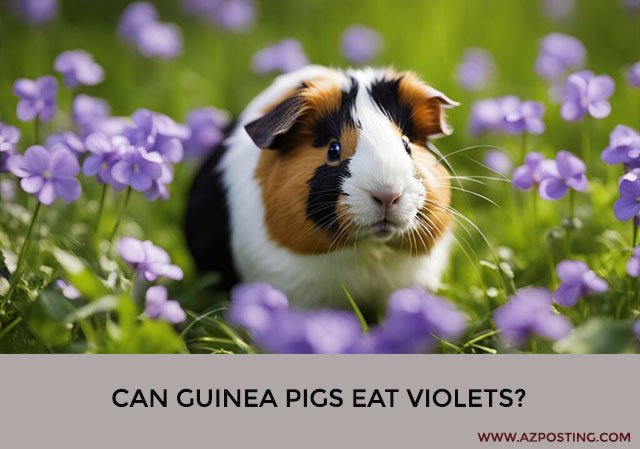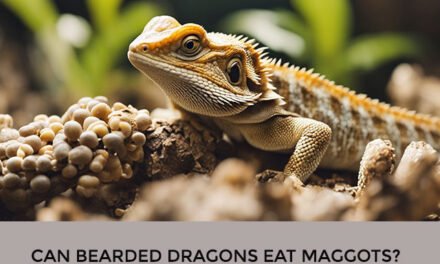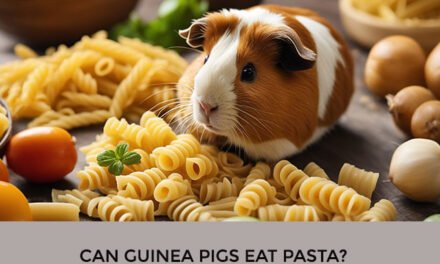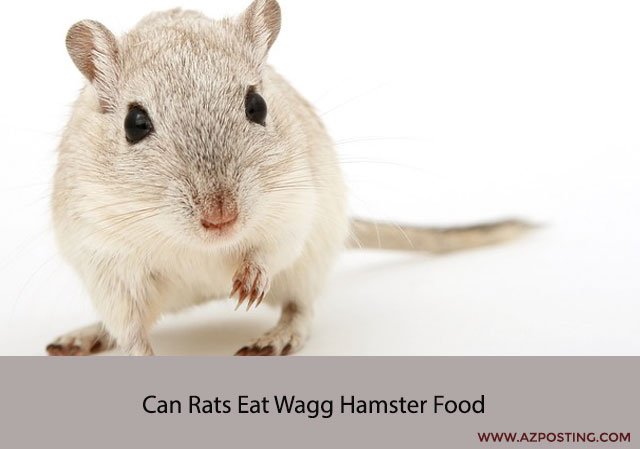Guinea pigs are adorable, affectionate, and social animals that love to munch on fresh fruits and vegetables. As a responsible pet owner, it’s important to ensure that your furry friend’s diet is well-balanced and nutritious. While guinea pigs can eat a variety of fresh foods, it’s crucial to know which ones are safe and healthy for them to consume.
One question that often arises among guinea pig owners is whether or not violets are safe for their pets to eat. Violets are a common garden plant that produces beautiful purple, blue, and white flowers. In this article, we will explore whether or not guinea pigs can eat violets and what precautions you should take if you decide to feed them to your furry friend.
Guinea Pig Dietary Basics
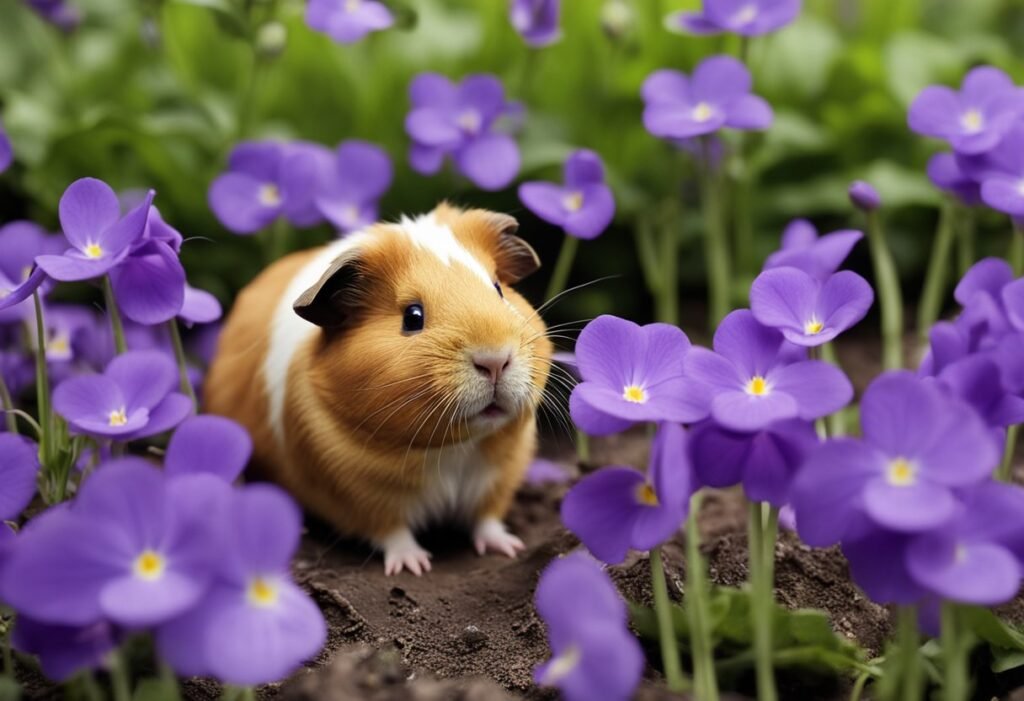
Nutritional Needs
As herbivores, guinea pigs require a diet rich in fiber, vitamin C, and other essential nutrients. In the wild, they eat mainly grasses and leafy greens, which provide the necessary nutrition for their bodies to function properly. In captivity, it is important to replicate this natural diet as closely as possible to keep them healthy and happy.
Guinea pigs have a unique digestive system that requires them to constantly eat and chew to maintain proper gut health. This means that they need access to hay and fresh water at all times. In addition to hay, they should be given a variety of fresh vegetables and fruits to provide them with the vitamins and minerals they need.
Safe Foods for Guinea Pigs
Not all plants are safe for guinea pigs to eat, and it is important to be aware of what foods are toxic to them. Some common foods to avoid include chocolate, caffeine, avocado, and onions. In general, it is best to stick to fresh vegetables and fruits that are safe for them to eat.
When it comes to violets, they are safe for guinea pigs to eat in moderation. However, they should not be the main source of nutrition for your pet. Violets are low in calories and do not provide a significant amount of essential nutrients that guinea pigs need. It is important to offer a variety of safe foods to ensure that they are getting a balanced diet.
In conclusion, guinea pigs have specific dietary needs that must be met to keep them healthy. Providing them with a variety of fresh vegetables, fruits, and hay will help ensure that they receive the necessary nutrients they need to thrive. While violets are safe for them to eat in moderation, they should not be relied upon as a primary food source.
Benefits of Violets for Guinea Pigs
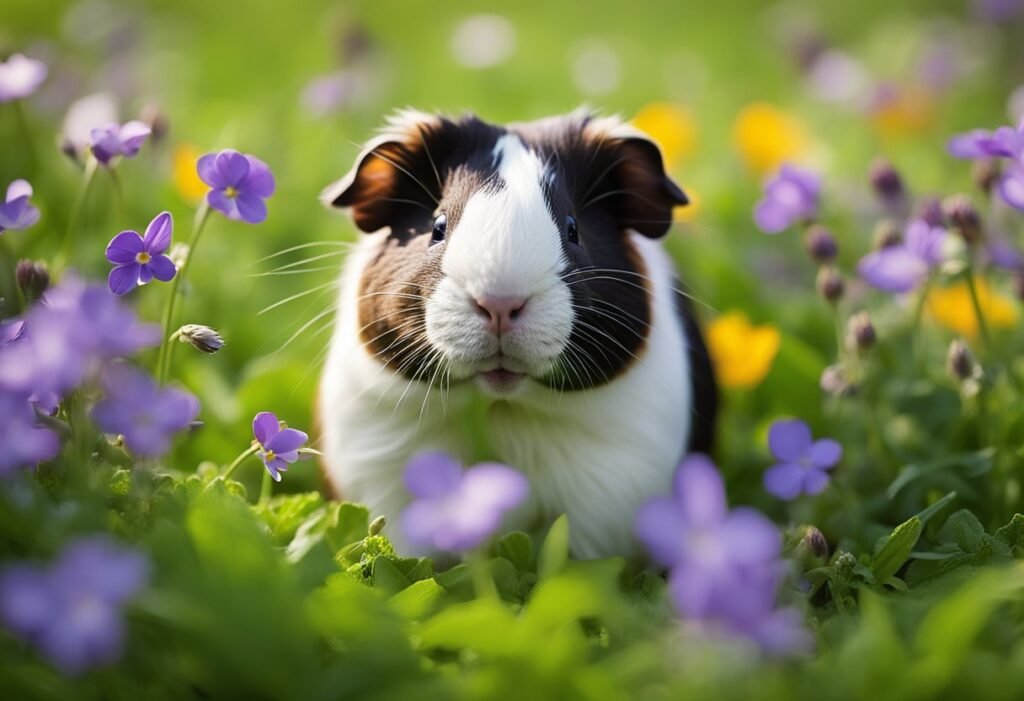
When it comes to feeding our guinea pigs, it’s important to provide them with a balanced diet that includes a variety of fresh fruits and vegetables. Violets are one such vegetable that can be a healthy addition to their diet. Here are some of the benefits of violets for guinea pigs:
Vitamin C Content
Vitamin C is essential for guinea pigs as they are unable to produce it themselves. Violets are a good source of vitamin C, with 100 grams of violet leaves containing around 50 milligrams of vitamin C. This makes them a great addition to their diet, helping to keep them healthy and prevent scurvy.
Digestive Health
Violets are also high in fiber, which is important for maintaining good digestive health in guinea pigs. The fiber helps to keep their digestive system functioning properly and can prevent issues such as constipation. Additionally, the leaves of the violet plant contain mucilage, a gel-like substance that can help soothe and protect the digestive tract.
Overall, violets can be a healthy and tasty addition to your guinea pig’s diet. However, as with any new food, it’s important to introduce them gradually and in small amounts to prevent any digestive upset.
Risks of Feeding Violets to Guinea Pigs
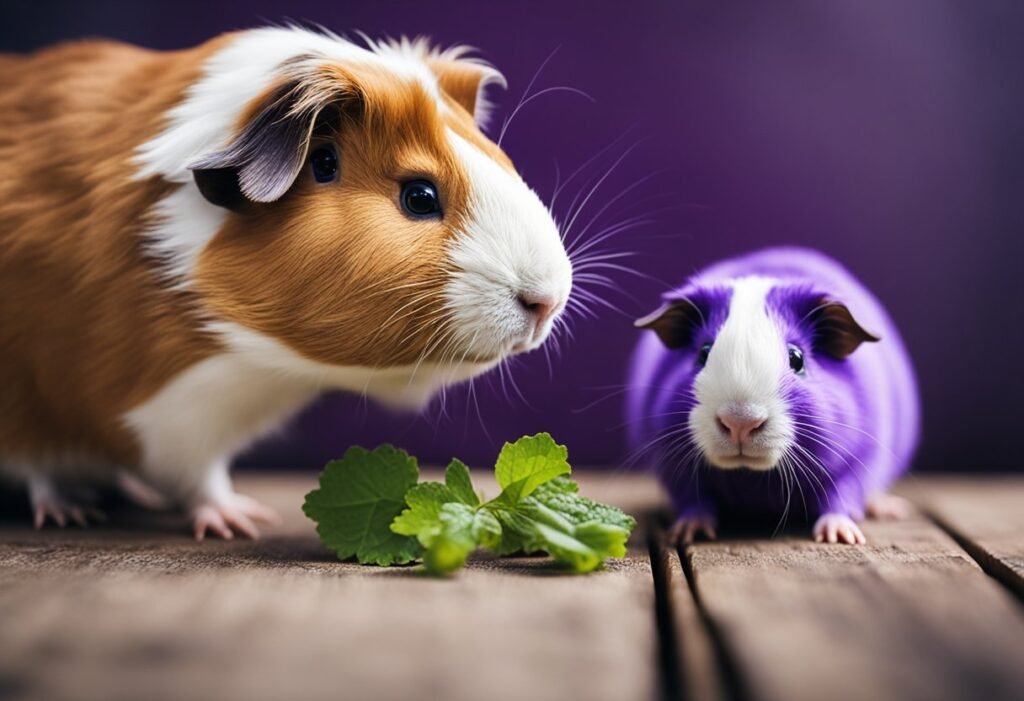
Feeding guinea pigs a variety of fresh fruits and vegetables is essential for their health and well-being. However, not all plants are safe for them to consume. In this section, we will discuss the risks associated with feeding violets to guinea pigs.
Potential Toxins
Violets contain a small amount of oxalic acid, which is a natural compound found in many plants. In high concentrations, oxalic acid can bind with calcium and form calcium oxalate crystals, which can cause health problems such as kidney stones and bladder stones in guinea pigs.
In addition, some species of violets contain anthocyanins, which are pigments that give the flowers their purple, blue, or red color. While anthocyanins are not toxic to guinea pigs, some studies suggest that they may cause digestive issues and diarrhea in some animals.
Allergic Reactions
Guinea pigs can be allergic to certain plants, including violets. Symptoms of an allergic reaction may include sneezing, coughing, wheezing, itching, and skin irritation. If you notice any of these symptoms after feeding your guinea pig violets, stop immediately and consult your veterinarian.
In conclusion, while violets are not toxic to guinea pigs in small quantities, they can cause health problems and allergic reactions in some animals. It is best to avoid feeding violets to your guinea pig and stick to safe, healthy foods that are specifically recommended for them.
Feeding Guidelines
When it comes to feeding violets to guinea pigs, it is important to follow some guidelines to ensure their health and safety. Here are some things to keep in mind:
Portion Control
Guinea pigs have delicate digestive systems and can suffer from various health problems if they eat too much or too little. Therefore, it is important to control the portions of violets you feed to your guinea pig. We recommend giving them a small amount of violets as a treat, no more than once or twice a week. A portion size should be no larger than a small handful of violets.
Frequency of Feeding
While violets are not a necessary part of a guinea pig’s diet, they can be a healthy and tasty treat in moderation. However, it is important to not overfeed your guinea pig with violets. We recommend feeding them violets no more than once or twice a week.
It is also important to note that violets should not replace a guinea pig’s main diet of hay, pellets, and fresh vegetables. Violets should be given as a supplement to a balanced and nutritious diet.
In summary, violets can be a healthy and tasty treat for guinea pigs when given in moderation. Controlling portion sizes and frequency of feeding is important to ensure their health and safety. Remember to always provide your guinea pig with a balanced and nutritious diet to keep them happy and healthy.
Types of Violets
Violets are a popular flowering plant that come in many different varieties. In this section, we will take a closer look at some of the most common types of violets and their characteristics.
Common Violet Varieties
- Sweet Violet (Viola odorata): This is the most common violet variety, known for its sweet fragrance. It is often used in perfumes, cosmetics, and as a flavoring in food.
- Dogtooth Violet (Erythronium dens-canis): This violet variety is also known as the Trout Lily. It is a spring-blooming plant that has unique mottled leaves.
- African Violet (Saintpaulia): This is a popular houseplant that comes in a variety of colors including pink, purple, and white. It is known for its fuzzy leaves and delicate flowers.
Edible vs. Ornamental Violets
When it comes to violets, there are two main categories: edible and ornamental. Edible violets are safe for consumption and are often used in salads, desserts, and as a garnish. Ornamental violets, on the other hand, are not meant to be eaten and can be toxic if ingested.
It is important to note that not all edible violets are created equal. Some varieties, such as the Sweet Violet, are safe to eat, while others, like the Dogtooth Violet, should be avoided.
In conclusion, understanding the different types of violets and their characteristics can help you make informed decisions about which varieties to grow and consume.
Preparation of Violets
When it comes to feeding guinea pigs, it’s important to prepare their food properly to ensure they receive the right nutrients and avoid any potential health risks. Here’s how to prepare violets for your furry friend.
Cleaning Process
Before serving violets to your guinea pig, it’s important to clean them thoroughly to remove any dirt, pesticides, or other contaminants. Here’s how we suggest cleaning violets:
- Rinse the violets under cold running water to remove any visible dirt or debris.
- Soak the violets in a bowl of cold water for 5-10 minutes to loosen any remaining dirt or debris.
- Rinse the violets again under cold running water to remove any remaining dirt or debris.
- Pat the violets dry with a clean towel or paper towel.
Serving Suggestions
Once you’ve cleaned the violets, it’s time to serve them to your guinea pig. Here are a few serving suggestions:
- Offer violets as a standalone treat or mix them in with your guinea pig’s regular food.
- Serve violets fresh or dried. Dried violets can be a good option if you want to store them for longer periods of time.
- Offer violets in moderation. While violets are safe for guinea pigs to eat, they should be considered a treat rather than a staple food item.
By following these preparation and serving suggestions, you can safely offer violets as a tasty and nutritious treat for your guinea pig.
Alternative Guinea Pig Foods
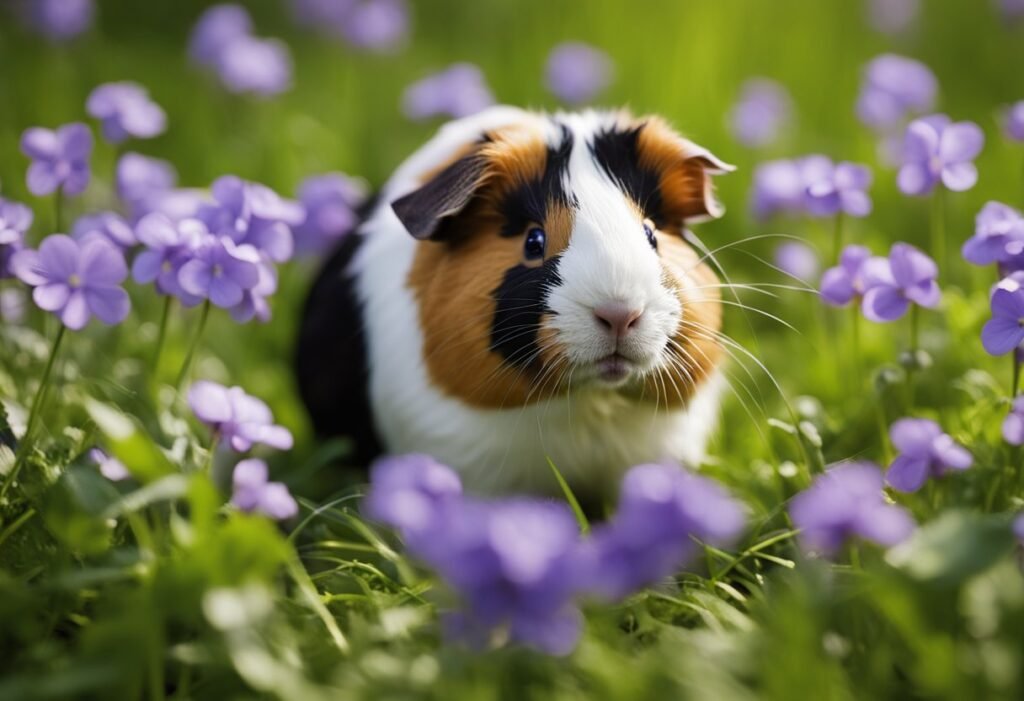
When it comes to feeding guinea pigs, it’s important to provide them with a well-balanced diet that includes a variety of foods. While hay should make up the majority of their diet, it’s also important to include fresh vegetables and fruits, as well as commercial guinea pig food. Here are some alternative food options to consider:
Vegetables and Fruits
Guinea pigs enjoy a variety of vegetables and fruits, but it’s important to introduce new foods slowly to avoid digestive issues. Here are some safe options to consider:
- Leafy greens: romaine lettuce, kale, spinach, parsley, cilantro
- Bell peppers
- Carrots
- Cucumbers
- Tomatoes (in moderation)
- Apples (without seeds)
- Bananas
- Berries (strawberries, blueberries, raspberries)
It’s important to note that some vegetables and fruits can be high in sugar or calcium, so it’s best to feed them in moderation. Also, avoid feeding your guinea pig any toxic foods such as onions, garlic, or avocado.
Commercial Guinea Pig Food
Commercial guinea pig food is a convenient way to ensure your pet is getting all the necessary nutrients in their diet. Look for a high-quality, pelleted food that’s specifically formulated for guinea pigs. Avoid any food that contains seeds, nuts, or dried fruit, as these can be high in fat and sugar.
In addition to pelleted food, you can also offer your guinea pig hay-based treats such as hay cubes or hay balls. These can help keep their teeth healthy and provide some variety in their diet.
Overall, providing your guinea pig with a well-balanced diet is essential for their health and well-being. By including a variety of foods, you can help ensure they’re getting all the necessary nutrients they need to thrive.
Frequently Asked Questions
Are violet seeds safe for guinea pigs to consume?
We do not recommend feeding violet seeds to guinea pigs. While violets themselves are safe for guinea pigs to eat, the seeds can be a choking hazard and should be avoided.
How often can guinea pigs have violets included in their diet?
Violets can be given to guinea pigs as a treat in moderation. We recommend offering a small amount once or twice a week.
Which flowers are considered toxic to guinea pigs?
Some flowers that are toxic to guinea pigs include daffodils, tulips, lilies, and azaleas. It’s important to research any flowers before giving them to your guinea pig.
Can guinea pigs eat other types of leaves and flowers, such as rose leaves or jasmine?
Guinea pigs can eat a variety of leaves and flowers, but it’s important to research each type beforehand. Rose leaves and jasmine are safe for guinea pigs to eat in moderation.
Are there any risks involved with feeding petunias and nasturtium leaves to guinea pigs?
Petunias and nasturtium leaves are safe for guinea pigs to eat in moderation. However, it’s important to avoid feeding them too much as they can cause digestive issues.
What are the general feeding guidelines for plants and flowers in a guinea pig’s diet?
Plants and flowers should only be given to guinea pigs as a treat and should not make up the majority of their diet. It’s important to research each type of plant or flower before giving it to your guinea pig and to introduce new foods slowly to avoid digestive issues.

